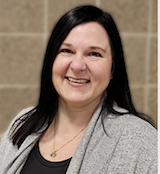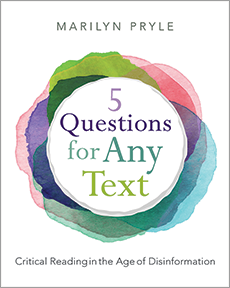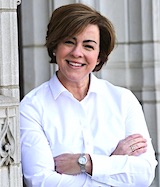5 Questions for Any Text: Critical Reading in the Age of Disinformation
By Marilyn Pryle
(Heinemann, 2024 – Learn more)
Reviewed by Melinda Stewart
 In 5 Questions for Any Text, Marilyn Pryle provides a practical framework for cultivating critical readers and thinkers in an age of information (and misinformation) overload. Aimed at middle and high school educators, this book presents a structured yet flexible approach for helping students move beyond surface-level comprehension toward deeper analysis, reflection, and awareness.
In 5 Questions for Any Text, Marilyn Pryle provides a practical framework for cultivating critical readers and thinkers in an age of information (and misinformation) overload. Aimed at middle and high school educators, this book presents a structured yet flexible approach for helping students move beyond surface-level comprehension toward deeper analysis, reflection, and awareness.
At the heart of Pryle’s method are five deceptively simple yet profoundly effective questions that guide readers: What am I reading? What is it showing me? What is it hiding? How am I reacting? How does it work?
 Leaning into reader response theory, developed by Louise Rosenblatt, Pryle highlights that reading is a transactional process between reader and text. The five guiding questions Pryle poses invite students to pause, question, and engage in a genuine dialogue with and about the text.
Leaning into reader response theory, developed by Louise Rosenblatt, Pryle highlights that reading is a transactional process between reader and text. The five guiding questions Pryle poses invite students to pause, question, and engage in a genuine dialogue with and about the text.
Through this lens, students learn to discern purpose, credibility, bias, audience, and message. By using these questions as a framework, teachers are developing their students’ ability to question assumptions and think critically about what they encounter both in and beyond the classroom.
Accessible and adaptable across grades
Pryle’s method is both accessible and adaptable, making it valuable for teachers across grade levels and subjects. Early in the book, she introduces educators to the role of structured reading response. Reading response is a tool for connecting readers with text, students to students, and teacher to student. In her discussion, Pryle distinguishes between summarizing and thinking originally, urging students to go beyond retelling to exploring deeper meanings, motives, and implications.
Pryle highlights that a text is never just a text, encouraging readers to consider genre, rhetoric, and the intersection between personal experience and cultural norms. By asking students to identify what a text reveals and conceals, Pryle’s framework guides readers to question credibility, to recognize bias in the text and in themselves, and to monitor their own reactions and assumptions. Her guidance does the same for teachers who are choosing the texts and facilitating the discussions.
A practical book with many resources
I’ll admit I was a little nervous after reading the first few pages. I thought it was great information and I could use the ideas in my classroom, but I also thought it was wrapped up for me like an informative article or blog post. I couldn’t imagine what Pryle would say for another 100 pages, but I continued reading and I was pleasantly surprised by the connection to the 5 questions and the book’s practicality.
Pryle provides clear lesson plans, discussion prompts, and examples of student work that show how the five-question framework can be integrated into everyday instruction and across disciplines. Her approach begins with trust and starting small, giving students structured entry points before gradually transferring ownership of analysis and discussion to them. The result is a classroom culture where students learn to have rational, evidence-based discussions, even when they disagree.
Equally powerful is Pryle’s emphasis on discussion and inquiry. Reading, she argues, is transactional. Her approach helps students develop layers of awareness, recognize the rhetoric and bias at play within themselves and within the text. Students learn to explore how texts shape and reflect the world around them and how to interact with text. This method empowers students to think, to question beyond the surface, to connect ideas, and to reflect critically on their own perspectives and emotions while reading, rather than simply accepting what a text says.
An invaluable resource that’s urgent and empowering
5 Questions for Any Text stands as an invaluable resource for educators seeking to nurture critical consciousness in their students. Pryle’s framework equips readers with the tools to interrogate information, recognize bias, and engage meaningfully with texts of all kinds. In a time when algorithms and echo chambers shape much of what students read and believe,
Pryle’s message is both urgent and empowering: if we want students to become critical readers, we must start by giving them the responsibility, and the right questions, to monitor their comprehension and think for themselves.
See Marilyn Pryle’s MiddleWeb series
exploring her five questions.
Melinda Stewart has been an educator for 30 years. She has an MA in Teaching, Education and Learning and has done graduate work in the areas of English as a Second Language, Reading, Spanish, and most recently English Language Arts. She is currently working as a Spanish teacher at Fairmont Junior Senior High School. Melinda is an MEA and AFT professional development facilitator and trainer who has a deep passion for learning and equity.



